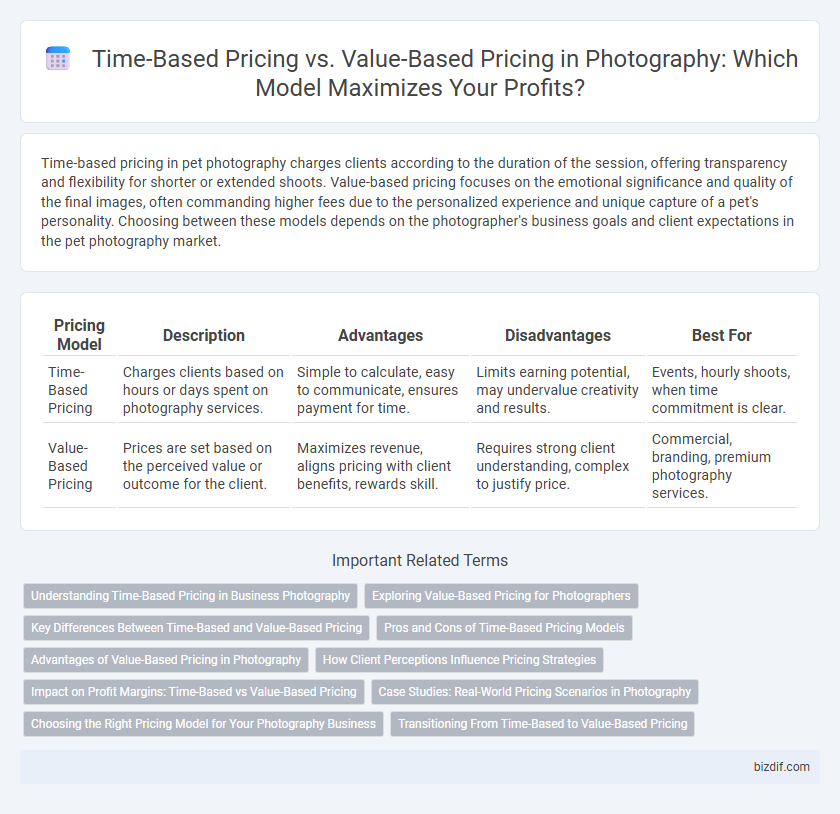Time-based pricing in pet photography charges clients according to the duration of the session, offering transparency and flexibility for shorter or extended shoots. Value-based pricing focuses on the emotional significance and quality of the final images, often commanding higher fees due to the personalized experience and unique capture of a pet's personality. Choosing between these models depends on the photographer's business goals and client expectations in the pet photography market.
Table of Comparison
| Pricing Model | Description | Advantages | Disadvantages | Best For |
|---|---|---|---|---|
| Time-Based Pricing | Charges clients based on hours or days spent on photography services. | Simple to calculate, easy to communicate, ensures payment for time. | Limits earning potential, may undervalue creativity and results. | Events, hourly shoots, when time commitment is clear. |
| Value-Based Pricing | Prices are set based on the perceived value or outcome for the client. | Maximizes revenue, aligns pricing with client benefits, rewards skill. | Requires strong client understanding, complex to justify price. | Commercial, branding, premium photography services. |
Understanding Time-Based Pricing in Business Photography
Time-based pricing in business photography involves charging clients based on the hours or days spent on a project, which provides clear cost expectations tied to photographer availability and labor intensity. This pricing model simplifies budgeting by quantifying the session length, editing time, and travel involved, making it ideal for clients needing straightforward, time-specific deliverables. Understanding time-based pricing helps photographers manage workload efficiency and project scope while maintaining transparent communication on service value.
Exploring Value-Based Pricing for Photographers
Value-based pricing for photographers centers on the perceived worth of their work to clients, factoring in elements like emotional impact, exclusivity, and brand reputation, rather than relying solely on hours spent or costs incurred. This approach can increase profitability by aligning prices with the unique benefits and outcomes delivered through custom shots, event coverage, or commercial projects. By emphasizing storytelling, client satisfaction, and market differentiation, photographers can justify premium rates and cultivate long-term relationships with discerning customers.
Key Differences Between Time-Based and Value-Based Pricing
Time-based pricing in photography charges clients according to the hours spent shooting or editing, offering straightforward cost predictability. Value-based pricing, however, sets fees based on the perceived value and impact of the final images on the client's goals, often resulting in higher profitability for specialized services. Key differences include the focus on input (time) versus output (value), pricing flexibility, and client willingness to pay for outcomes rather than mere labor.
Pros and Cons of Time-Based Pricing Models
Time-based pricing in photography charges clients according to the hours or days spent on a project, offering clear and straightforward billing that ensures photographers are compensated for all worked time. This model benefits photographers with predictable workflows and straightforward assignments but can limit earning potential on fast, high-value projects where creative impact outweighs time spent. However, it may lead to client dissatisfaction if perceived as inefficient or if sessions run longer than expected, emphasizing the need for accurate time management and transparent communication.
Advantages of Value-Based Pricing in Photography
Value-based pricing in photography maximizes revenue by aligning prices with the perceived value and emotional impact delivered to clients, rather than just time spent shooting or editing. This approach enhances client satisfaction by emphasizing the uniqueness and quality of the final product, leading to stronger client relationships and repeat business. Photographers benefit from increased profitability and market differentiation by leveraging their creative expertise and brand reputation in pricing strategies.
How Client Perceptions Influence Pricing Strategies
Client perceptions significantly shape photography pricing strategies by framing the perceived worth of services beyond mere time investment. Time-based pricing directly correlates charges to hours spent, appealing to clients valuing transparency and control. Value-based pricing hinges on the perceived creativity, expertise, and final deliverables, often commanding higher fees when clients associate the photographer's brand with exceptional quality and unique outcomes.
Impact on Profit Margins: Time-Based vs Value-Based Pricing
Time-based pricing in photography calculates fees based on hours worked, often limiting profit margins when tasks extend unexpectedly. Value-based pricing aligns charges with the perceived client value of the final images, typically enhancing profit margins by capturing the true market worth of creative expertise. Photographers leveraging value-based pricing can maximize revenue by focusing on the unique impact and quality delivered rather than merely the time invested.
Case Studies: Real-World Pricing Scenarios in Photography
Case studies in photography reveal that time-based pricing, charging per hour or session length, often leads to predictable income but may undervalue unique creative efforts. Value-based pricing analyzes the perceived worth to the client, such as event significance or image usage, resulting in higher profitability and client satisfaction. Photographers employing value-based strategies report improved alignment with market demand and enhanced brand positioning compared to fixed time-based fees.
Choosing the Right Pricing Model for Your Photography Business
Time-based pricing charges photographers per hour or session length, offering clear billing for straightforward projects but may undervalue creativity and final output quality. Value-based pricing considers the unique value of the images to clients, reflecting their emotional or commercial worth, which can maximize revenue for high-demand photographers or specialized niches. Selecting the right pricing model depends on factors like client expectations, project complexity, and market positioning, balancing efficiency with perceived value to grow a sustainable photography business.
Transitioning From Time-Based to Value-Based Pricing
Transitioning from time-based pricing to value-based pricing in photography requires assessing the unique value each project delivers to clients rather than charging solely for hours worked. Photographers should analyze client goals, expected outcomes, and the perceived worth of their creative expertise to set prices that reflect the true benefits of their services. Emphasizing value-based pricing enhances profitability and aligns pricing strategies with client satisfaction and market demand.
Time-Based Pricing vs Value-Based Pricing Infographic

 bizdif.com
bizdif.com